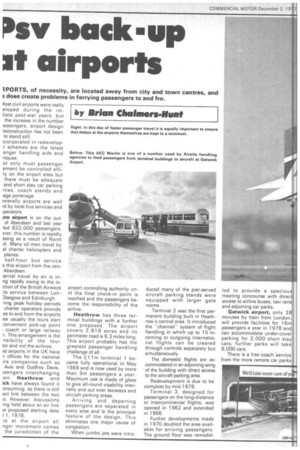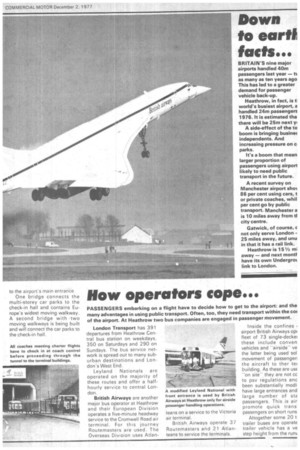lisv back-up
Page 76

Page 77

If you've noticed an error in this article please click here to report it so we can fix it.
at airports
1PORTS, of necessity, are located away from city and town centres, and 3 does create problems in ferrying passengers to and fro.
lost civil airports were really eloped during the imhate post-war years, but the increase in the number iassengers, airport design reconstruction has not been to stand still.
icorporated in redevelopt schemes are the latest enger handling aids and riiques.
ot only must passenger ement be controlled effily on the airport sites but there must be adequate and short stay car parking ities, coach stands and age porterage.
anerally airports are well id by local bus services and werators.
fce airport is on the outof Aberdeen and last year led 822,000 passengers. neer, this number is rapidly asing as a result of North Many oil men travel by al charter helicopters and planes.
half-hour bus service S this airport from the cenAberdeen.
Lernal travel by air is inng rapidly owing to the inction of the British Airways :le service between Lonllasgow and Edinburgh. ring peak holiday periods charter operators provide es to and from the airports Ise usually the tours start -;onvenient pick-up point coach or large railway 1. This arrangement is the ,nsibility of the tour or and not the airlines. 1st airports in the UK have
offices for the national ire companies such as Avis and Godfrey Davis. ;sengers interchanging ;en Heathrow and ick have always found it onsuming, as there is still ect link between the two s. However, discussions ing held about an air link ie proposed starting date I 1, 1978.
at the airport all nger movement comes the jurisdiction of the airport controlling authority until the final check-in point is reached and the passengers become the responsibility of the airline.
Heathrow has three terminal buildings with a further one proposed. The airport covers 2,819 acres and its perimeter road is 9.3 miles long. This airport probably has the greatest passenger handling challenge of all.
The £11m terminal 1 became fully operational in May 1969 and is now used by more than 9m passengers a year. Maximum use is made of glass to give all-round visability internally and out over taxiways and aircraft parking areas.
Arriving and departing passengers are separated in every area and is the principal feature of the design. This eliminates one major cause of congestion.
When jumbo jets were intro
duced many of the pier-served aircraft parking stands were equipped with larger gate rooms.
Terminal 2 was the first permanent building built in Heathrow's central area. It introduced the "channel' system of flight handling in which up to 10 incoming or outgoing international flights can be cleared through controls separately but simultaneously.
The domestic flights are accommodated in an adjoining wing " of the building with direct access to the aircraft parking area.
Redevelopment is due to be complete by mid-1978.
Terminal 3, designed for passengers on the long-distance or intercontinental flights, was opened in 1962 and extended in 1966.
Further developments made in 1 970 doubled the area available for arriving passengers. The ground floor was remodel
led to provide a spaciouq meeting concourse with direc access to airline buses, taxi ran and adjoining car parks.
Gatwick airport, only 3 minutes by train from London, will provide facilities for 16m passengers a year in 1978 and can accommodate under-cove parking for 2,000 short stay cars; further parks will take 6,000 cars.
There is a free coach -service from the more remote car parks
to the airport's main entrance One bridge connects the multi-storey car parks to the check-in hall and contains Europe's widest moving walkway. A second bridge with two moving walkways is being built and will connect the car parks to the check-in hall.














































































































































